#show don't tell
Explore tagged Tumblr posts
Text
Zoom In, Don’t Glaze Over: How to Describe Appearance Without Losing the Plot
You’ve met her before. The girl with “flowing ebony hair,” “emerald eyes,” and “lips like rose petals.” Or him, with “chiseled jawlines,” “stormy gray eyes,” and “shoulders like a Greek statue.”
We don’t know them.
We’ve just met their tropes.
Describing physical appearance is one of the trickiest — and most overdone — parts of character writing. It’s tempting to reach for shorthand: hair color, eye color, maybe a quick body scan. But if we want a reader to see someone — to feel the charge in the air when they enter a room — we need to stop writing mannequins and start writing people.
So let’s get granular. Here’s how to write physical appearance in a way that’s textured, meaningful, and deeply character-driven.
1. Hair: It’s About Story, Texture, and Care
Hair says a lot — not just about genetics, but about choices. Does your character tame it? Let it run wild? Is it dyed, greying, braided, buzzed, or piled on top of her head in a hurry?
Good hair description considers:
Texture (fine, coiled, wiry, limp, soft)
Context (windblown, sweat-damp, scorched by bleach)
Emotion (does she twist it when nervous? Is he ashamed of losing it?)
Flat: “Her long brown hair framed her face.”
Better: “Her ponytail was too tight, the kind that whispered of control issues and caffeine-fueled 4 a.m. library shifts.”
You don’t need to romanticise it. You need to make it feel real.
2. Eyes: Less Color, More Connection
We get it: her eyes are violet. Cool. But that doesn’t tell us much.
Instead of focusing solely on eye color, think about:
What the eyes do (do they dart, linger, harden?)
What others feel under them (seen, judged, safe?)
The surrounding features (dark circles, crow’s feet, smudged mascara)
Flat: “His piercing blue eyes locked on hers.”
Better: “His gaze was the kind that looked through you — like it had already weighed your worth and moved on.”
You’re not describing a passport photo. You’re describing what it feels like to be seen by them.
3. Facial Features: Use Contrast and Texture
Faces are not symmetrical ovals with random features. They’re full of tension, softness, age, emotion, and life.
Things to look for:
Asymmetry and character (a crooked nose, a scar)
Expression patterns (smiling without the eyes, habitual frowns)
Evidence of lifestyle (laugh lines, sun spots, stress acne)
Flat: “She had a delicate face.”
Better: “There was something unfinished about her face — as if her cheekbones hadn’t quite agreed on where to settle, and her mouth always seemed on the verge of disagreement.”
Let the face be a map of experience.
4. Bodies: Movement > Measurement
Forget dress sizes and six packs. Think about how bodies occupy space. How do they move? What are they hiding or showing? How do they wear their clothes — or how do the clothes wear them?
Ask:
What do others notice first? (a presence, a posture, a sound?)
How does their body express emotion? (do they go rigid, fold inwards, puff up?)
Flat: “He was tall and muscular.”
Better: “He had the kind of height that made ceilings nervous — but he moved like he was trying not to take up too much space.”
Describing someone’s body isn’t about cataloguing. It’s about showing how they exist in the world.
5. Let Emotion Tint the Lens
Who’s doing the describing? A lover? An enemy? A tired narrator? The emotional lens will shape what’s noticed and how it’s described.
In love: The chipped tooth becomes charming.
In rivalry: The smirk becomes smug.
In mourning: The face becomes blurred with memory.
Same person. Different lens. Different description.
6. Specificity is Your Superpower
Generic description = generic character. One well-chosen detail creates intimacy. Let us feel the scratch of their scarf, the clink of her earrings, the smudge of ink on their fingertips.
Examples:
“He had a habit of adjusting his collar when he lied — always clockwise, always twice.”
“Her nail polish was always chipped, but never accidentally.”
Make the reader feel like they’re the only one close enough to notice.
Describing appearance isn’t just about what your character looks like. It’s about what their appearance says — about how they move through the world, how others see them, and how they see themselves.
Zoom in on the details that matter. Skip the clichés. Let each description carry weight, story, and emotion. Because you’re not building paper dolls. You’re building people.
#writeblr#writing community#writers of tumblr#writing tips#character development#creative writing#writing advice#character description#descriptive writing#show don't tell#world building#narrative voice#writing help#fiction writing#amwriting#writing characters
9K notes
·
View notes
Text
On Lovecraftian Horror

Happy Friday!
There you are sitting at your desk, maybe you're working longhand or your fingertips are tapping atop unpressed keys, and BAM! You have an idea that involves a monster that could've oozed its way right out of the Cthulhu Mythos.
Before you begin, pause a moment.
I get it. I like stories of the vast unknowable myself. I grew up playing Mass Effect and I'm particularly fond of the way Jason Pargin was able to nail it in his John Dies At The End series, and in such a way that I cared about the characters and their humors in spite of the overwhelming, multidimensional terrors that hunt them, but that's because I prefer heavily character driven stories and that's a diatribe for another day.
I've read a lot of aspiring fiction in this genre, and my main critique, the most common pitfall I see within cosmic horror, has nothing to do with character, setting, worldbuilding, or language. It has everything to do with writing that which is inherently unknowable, assuming you're trying to follow convention.
In other words: The monster has to be as alien to you as it is to the reader and characters. Forty page character sheets won't work here because at this point your "monster" isn't really a character. Remember, it isn't a being you can intelligently understand, and that's where the horror lives. It's a reckoning force defying nature, physics, and our fundamental understandings of science. Novels like The Three Body Problem by Cixin Lu illustrate this sense of scale and terror through sheer confusion and technological advancement.
Recall that Lovecraft's most popular story, The Call of Cthulhu, is epistolary. It's told through loose fragments, rumors, journal entries, it's never directly handled. Your job isn't to portray a gigantic, globular mass of eyes descending over New York City to deliver it's final judgement on humanity out of a thin blue Thursday afternoon. It should instead be the effect it has on the characters, or maybe second person to the reader itself, a virus in which just speaking or reading the name of your creature puts you at risk of harm.
One other issue I've come across in reading from a litany of fledgling unpublished fictioneers who take a stab at this genre is that it doesn't seem to be understood. The genre strongly echoes condemnation, damnation, the price of obsession, the price of knowledge, the price of ignorance, yes, but also the warning in bland optimism.
"Yeah, I'll just pledge my eternal soul to this unknowable deity 40,000 eons older than me, and then I will wield all the power."
That sounds dumb out of context, doesn't it?
It's not just about feeling earned or not, either. At this point, whether our earthly brother understands this or not, he's simply a vessel unbolting the latches of an old door sealed an unknowable amount of time before he existed. If we haven't been following him, haven't seen his transformation from upstanding citizen with a healthy few indelible and mortal sins to a hunched over, hooded lunatic who hides his deeds away from the very sun he orbits, this often lands flat and assumes stupidity on the part of your audience.
That's what makes this particular brand of horror so difficult, in my opinion. The balance from describing an unknowable, unfathomable monster that shifts through dimensions so as not to be physically described vs. making sure the audience knows that said impossible, indescribable force is destroying your character's mental state. Anyone can write, "I looked at the monster and it's very essence shattered my mind, scrambling it into a dark and forbidden wind, and even now trying to recall it sends shivers down my spine and vomit up my throat". It works. But it's flat without knowing who this character was beforehand. A slick talking lawyer bursting with personality? Okay, now we're getting somewhere.
So:
Before you start make sure
Your main character isn't your deity
Your main character is fleshed out well
Writing/reading is about the only time cosmic horror can work because it blends on disengaged senses. You're not really seeing, smelling, tasting, hearing, touching, but you are feeling. It's why hardly any games work in the genre without over explaining themselves or coming off cheesy, same with certain films in my opinion.
Leverage that.
Leverage Plato's allegory of the cave, your readers have only known shadows.
Make us see more than shapes. If you’re into horror, cosmic dread, or writing craft talk like this, feel free to follow... I post often.
#lovecraftian horror#cosmic horror#writing advice#horror writing#storytelling#weird fiction#existential horror#jason pargin#john dies at the end#mass effect#the three body problem#cixin liu#writing tips#epistolary fiction#show don't tell#eldritch horror#the unknowable#platos cave#psychological horror#writers of tumblr#horrorblr#scifi horror
435 notes
·
View notes
Text
WRITING TIP: Make your dialogue beats do more.
A beat isn’t just filler; it’s how you write the silence.
The best beats reveal what’s felt, not said:
– hesitation
– discomfort
– tension
– hidden motive
What’s a beat?
A dialogue beat is a small action or thought that shapes rhythm and reveals what’s left unsaid.
Avoid:
“Sure,” she said, with a shrug.
(Filler beat. Adds no emotional value.)
Use beats with intent:
“Sure,” she said, without looking up from her phone.
(dismissive)
“It’s fine,” she said. The fight was over. And she’d lost.
(self-censorship)
“I’m fine.” He lined up the silverware again - and again.
(anxiety)
A good beat doesn’t echo the line - it complicates it.
#writing community#fic writing#writing tips#character dialogue#writing dialogue#ao3 writer#writeblr#ao3 author#writing advice#fiction writing#show don't tell#amwriting#writing notes#writing process#writting#character driven stories#a crown of thorns#ao3 fanfic#ao3fic#creative writing#writing#writers on tumblr#writerscommunity#writers and poets#writer stuff#writblr#dialogue beats#fanfiction#fanfic#fanfiction writer
278 notes
·
View notes
Text
Some examples of "show, don't tell"
Telling: Leila was very angry.
Showing: Leila's face turned red, her fists clenched, and she slammed the door shut.
⸻
Telling: The room was messy.
Showing: Clothes were strewn across the floor, books were piled haphazardly on the desk, and dirty dishes filled the sink.
⸻
Telling: John was scared of heights.
Showing: John's palms grew sweaty, his heart raced, and he clung tightly to the railing as he looked down from the rooftop.
⸻
Telling: The food tasted delicious.
Showing: The flavors exploded on her tongue, a medley of sweet, tangy, and savory notes danced in her mouth, leaving her craving more.
⸻
Telling: Emma was sad about the breakup.
Showing: Emma's eyes welled up with tears, her shoulders slumped, and she spent hours curled up in bed, replaying their last conversation in her mind.
⸻
Telling: It was a beautiful sunset.
Showing: The sky transformed into a canvas of vibrant hues—pinks, oranges, and purples blending together in a breathtaking display, casting a warm glow across the horizon.
⸻
Telling: The car was old and unreliable.
Showing: The engine coughed and sputtered, emitting puffs of smoke. Rust covered the body, and the faded paint revealed years of wear and tear.
⸻
Telling: The meeting was tense.
Showing: The participants leaned forward in their seats, their brows furrowed, and their voices became sharp and clipped as they argued back and forth.
⸻
Telling: He was a kind person.
Showing: He often went out of his way to help others, offering a comforting smile and lending a listening ear whenever someone needed support.
⸻
Telling: The forest was eerie at night.
Showing: Shadows danced among the trees, the wind whispered through the branches, and the distant hooting of an owl sent shivers down her spine.
Here’s the Show, Don’t Tell freebie book and my newsletter.
#show don't tell#writing#writerscommunity#writer on tumblr#writing tips#writing advice#writer tumblr#writing help#writblr#fiction writing#writer community#writer stuff#creative writing
442 notes
·
View notes
Text
My small addition to the "show don't tell" advice of storytelling is that in my opinion it's okay to use writing pitfalls like "Telling" the audience something if you intend to Also demonstrate ("show") it in the story.
For example "This is a story about a very grumpy guy." (que your main character road raging) (inciting incident happens and your protagonist reacts grumpily to it). Like it's not an inherent flaw depending on how you execute it AND even more importantly, the tone of your story. If your story is quippy, self aware, self narrating or various flavors of humor or self observant, it's okay to Just Tell the audience things. Not all things, but it can work for comedic effect or for exploring character observation and psychology, or doing a commentary on something. Works especially well if your narrator is actually a character within the story (ie. Person recalling events to someone)
ALSO importantly, you can use "Telling" for subverting expectations which can work towards either humor Or discomfort brilliantly.
"This is a story about a very grumpy guy" (que main character reacting completely normally to an event) (main character's reactions are treated as somehow overtly absurd and exaggerated by other characters despite them being very tame and reasonable). See what I mean?
It's okay to tell some things:
- if it serves the tone of your story
- if you ALSO show
- if it's funny
- if it's existentially horrifying
- if it serves towards an unreliable narrator
- if it makes the story interesting
- if it's not the point of the story to "show" some particular thing at all
I know people are gonna interpret the "Show don't tell" advice many different ways, so I wanted to add my two cents to it. I have way more to say, but here's my take in defence of "Telling". I believe in art and writing there's a time and place for any kind of narrative tools if you work with them well enough and know what you're doing.
#Mod talks#Writing advice#Meta#Storytelling#Show don't tell#Writing#Writblr#creative writing#Tropes#story tropes#Writing tropes
200 notes
·
View notes
Text
Another Post About Showing and Telling
I feel like it’s a rite of passage for a writing blog to talk about show, don’t tell, so I’ll take a crack at it.
First of all, to get it out of the way, show, don’t tell is good advice for specific situations, but it’s been taken to mean always show, never tell and that’s not helpful. If you really want to paint with broad brushstrokes, then the better advice would be: Show more than tell. Showing and telling should both be tools in your writer’s toolbox.
But why should we show more than tell? Because showing is the key to the reader's emotional experience with your story. There are many posts and books out there that go over how to turn your telling into showing (like using active verbs instead of passive, for example, or using concrete, specific details in your descriptions), but I think it’s important to fully digest why we’re making those changes and why the reasoning will push us to become better writers.
It all comes down to emotion. Writing For Emotional Impact by Karl Iglesias encourages writers to start thinking to themselves: “I’m in the emotion-delivery business, and my job is to evoke emotions in a reader.” Dialogue, theme, setting, pacing, character development, word choice, structure, POV, showing and telling. These are all tools a writer uses in varying proportions to best manipulate a reader’s emotions. The good news is that when a reader picks up a book, they’re willing to be manipulated. In fact, they hope to be. The tough news is that you have to deliver on a sentence by sentence, paragraph by paragraph, scene by scene, and chapter by chapter basis. But that’s okay, because you’re a writer, dammit, and this struggle is where the art of the craft is.
Showing is where the emotional complexities of our characters, theme, and plot can be revealed gradually without giving too much away too early and robbing engagement from the reader. Showing is what makes the resolution and the journey satisfying. So you can see how much weight it carries and why we want more of that than telling. We’re trying to evoke emotion from the reader, not talk at them like we’re recounting a dream we had last night (yawn). And it’s easier to evoke emotion if we keep them curious. Engaged.
Part of revealing the story gradually through showing is planting evidence for a conclusion that you leave the reader to make themselves, or a conclusion that you will reveal later. Donald Maas in The Emotional Craft of Fiction writes, “The ingredient behind effective showing can be summed up in this word: subtext. When there’s a feeling we’re not being told, but it is evident anyway, that underlying feeling is the subtext. It’s the unspoken emotional truth.” And then a fandom is born and continues to thrive for decades after the show ended! Really, though. Subtext is an ingredient in showing, which fosters engagement, which makes the reader feel something. Sometimes passionately. Every story I love and keep coming back to in one form or another has that special place in my heart because of how it made me feel.
I’ll try to give a simple example here to illustrate subtext and reader engagement at work. Using setting and a couple action beats as an opportunity for subtext, let’s say a character and her sister arrive at their grandmother’s house. Character A remains standing in the corner when invited in, hugging herself, frowning at the green knitted blanket hanging over the couch that looks like the color of nausea. Character B walks easily into the living room, running her hand over the green blanket that reminds her of nature and wellness. In Character B's perspective, she admires her grandmother's craftiness. But it's only in Character's A perspective that we notice the store tag on the blanket. Who do we think has the better relationship with their grandmother, given the evidence? Which one seems more naïve or eager to see her grandmother in a certain light? What assumptions can we make about the grandmother? Might she be putting on a performance of being grandmotherly? The mental work the reader does here would be completely thwarted if the scene had started with “Hannah didn’t like her grandmother because she valued material wealth and appearances over forming a genuine connection with her family.” We can show that instead over time by filtering the world through the perspectives of our characters, and even making it pack an emotional punch if we’re strategic about it.
But I had mentioned that contrary to what show, don’t tell asks us to do, telling isn’t something we should throw away. It can be a tool in its own right.
Telling is explaining, and explaining keeps people distant from what’s happening in the story. How many times has an “I love you” felt kinda meh in a story because that character hasn’t earned that confession by showing their love through their actions or making some sort of sacrifice? How many times have your eyes glazed over while reading the fourth paragraph of an info dump? How many times, when talking about a book you just read, have you said “well, the first 80 pages were slow…” because it was all backstory? Or maybe a story is entirely forgettable because the telling leaves nothing to the imagination. Donald Maas writes, “Put on a page what a character feels and there’s a pretty good chance that, paradoxically, what the reader feels is nothing.”
However, telling has one thing on showing: efficiency. If a book only showed, then it could go on forever and ever. So a writer has to learn how to weave both showing and telling into the story to control the pacing and delivery of information. If you want subtext or you want something to be vague on purpose, then you’ll probably want to show. If you want to deliver information quickly and with clarity, then you might want to try telling. Does it need to make logical sense to understand the upcoming scene? Maybe tell. Is this transition unimportant to the story and you don’t want to linger? Try telling and see how it works! Ask your beta readers how it worked for them. Of course, if you’re writing in the literary genre, you might be doing a whole lot of telling because what propels the reader to the next page and the next chapter is the form, the prose, and the sheer depth of the exploration of flawed characters.
It’s all about balance. And practice. Next time you read a book and you find yourself moved, try to figure out how the author just evoked that feeling from you. Was it stated plainly, or was it shown through action? Was it stated plainly after a whole book’s worth of setup through subtext? Was it unexpected? What was the balance of showing and telling that led to it? Or, if you find your focus trailing off, try to figure out why. Then, when you’re editing your own work, you’ll have the tools you need to identify the weak points and make revisions. And it’s okay (even expected) if the perfect balance of showing and telling doesn’t occur in the first draft. The Artful Edit by Susan Bell (highly recommended) talks a lot about the revisions that went into The Great Gatsby. You'll find that his writing struggles are comfortingly familiar. Luckily, he certainly had a wonderful editor :)
For further reading/watching:
[VIDEO] ShaelinWrites—Show, Don’t Tell | what it means and how to use it
[BOOK] Showing and Telling in Fiction by Marcy Kennedy [BOOK] A Writer’s Guide to Active Setting by Mary Buckham
#writing advice#writing tips#writing community#writers of tumblr#writing#creative writing#writeblr#fiction#show don't tell
206 notes
·
View notes
Text
Update: It turns out that this isn't quite true, so if you see this, please check out the correction over here, thanks!
So apparently, "show don't tell" was pushed as Really Good Writing Advice in the 1950's because it kept writers from discussing political ideas that challenged the status quo.
Which like... obviously, "show, don't tell" can be useful sometimes, like if you're describing a terrifying monster! But pushing it as The Only Way To Write would definitely have a chilling effect on stories centering concepts and experiences unfamiliar to readers.
I find it both fascinating and a little disturbing how effectively censorship can be accomplished through simply convincing people that certain forms of expression are gauche.
2K notes
·
View notes
Text
These two stills nicely show the passage of time during Sauron's goo phase. Stalactites and stalagmites do not grow exactly quickly.
It's only after the shot in the second still that Blobron devours the poor rat.
It means he was a black puddle for a very long time before he turned into a spaghetti monster, crawled out of the cave, had a sled adventure, was run over by a carriage and turned into Halbrand... possibly not of the Southlands. :-)
It's a lovely example of "show don't tell."


#the rings of power#rop season 2#rop spoilers#trop spoilers#rop stills#myropstills#blobron#rop visual storytelling#show don't tell
259 notes
·
View notes
Text
Am I mad that we only got told by a twitter post, as an afterthought after all the upsurge of indignation for the treatment reserved to Sam Wilson as Captain America, that he indeed had already assembled the Avengers offscreen?
YES.
Do I consider it not just sloppy and weak writing, breaking the SHOW DON'T TELL rule even the worst fanfic writer knows?
YES.
Do I think that with little minimal creative thinking, they could've used either (or both) CABNW or TB* post credit scene to show exactly this process?
YES.
But boy. C'mon. CABNW has its weaknesses, but this is ALL on the TB* creative team. The movie could've answered this question and many other....yet today we're still fucking wondering (and waiting for the next A/N to appear in a tweet):
WHEN the fuck did Bucky got elected?
WHY did he choose to run for Congress?
WHO eventually decided to put him there?
WHICH is exactly his role in the Congress?
HOW did he get elected?
WHERE do his political opinions and goals stand?
Did we even get any fucking explanation about this WHOLE MESS of a career?!?
NO.
Jesus. I hate to admit it, but somehow such a pathetically bad writing makes me consider actually acceptable that Somehow, Palpatine returned....
#anti thunderbolts#bad writing#show don't tell#sam wilson#captain america#sam wilson is captain america#cabnw#bucky barnes#the Avengers™
79 notes
·
View notes
Text
When Should You Describe a Character’s Appearance? (And When You Really, Really Shouldn’t)
It’s one of the first instincts writers have: describe your character. What they look like, what they wear, how they move. But the truth is — readers don’t need to know everything. And more importantly, they don’t want to know everything. At least, not all at once. Not without reason.
Let’s talk about when to describe a character’s appearance, how to do it meaningfully, and why less often says more.
1. Ask: Who Is Seeing Them? And Why Now?
The best descriptions are filtered through a perspective. Who’s noticing this character, and what do they see first? What do they expect to see, and what surprises them?
She looked like someone who owned every book you were supposed to have read in school. Glasses slipping down her nose. Sharp navy coat, sensible shoes, and an air of knowing too much too soon.
Now we’re not just learning what she looks like — we’re learning how she comes across. That tells us more than eye color ever could.
2. Use Appearance to Suggest Character, Not List Facts
Avoid long physical checklists. Instead, choose a few details that do double work — they imply personality, history, class, mood, or context.
Ineffective: She had long, wavy brown hair, green eyes, a small nose, and full lips. She wore jeans and a white shirt.
Better: Her hair was tied back like she hadn’t had time to think about it. Jeans cuffed, a shirt buttoned wrong. Tired, maybe. Or just disinterested.
You don’t need to know her exact features — you feel who she is in that moment.
3. Know When It’s Not the Moment
Introducing a character in the middle of action? Emotion? Conflict? Don’t stop the story for a physical description. It kills momentum.
Instead, thread it through where it matters.
He was pacing. Long-legged, sharp-shouldered — he didn’t seem built for waiting. His jaw kept twitching like he was chewing on the words he wasn’t allowed to say.
We learn about his build and his mood and his internal tension — all in motion.
4. Use Clothing and Gesture as Extension of Self
What someone chooses to wear, or how they move in it, says more than just what’s on their body.
Her sleeves were too long, and she kept tucking her hands inside them. When she spoke, she looked at the floor. Not shy, exactly — more like someone used to being half-disbelieved.
This is visual storytelling with emotional weight.
5. Finally: Describe When It Matters to the Story, Not Just the Reader
Are they hiding something? Trying to impress? Standing out in a crowd? Use appearance when it helps shape plot, stakes, or power dynamics.
He wore black to the funeral. Everyone else in grey. And somehow, he still looked like the loudest voice in the room.
That detail matters — it changes how we see him, and how others react to him.
TL;DR:
Don’t info-dump descriptions.
Filter visuals through a point of view.
Prioritize impression over inventory.
Describe only what tells us more than just what they look like — describe what shows who they are.
Because no one remembers a checklist.
But everyone remembers the girl who looked like she’d walked out of a forgotten poem.
#writeblr#writing community#writers of tumblr#writing tips#amwriting#character development#creative writing#writing advice#character design#show don't tell#narrative voice#fiction writing#creative writing tips#writing prompt
2K notes
·
View notes
Text
one of the positives of "show don't tell" is that it can be used to make readers ask and then answer their own questions. this is great because it is always great to get readers thinking and involving their imagination and their perspective.
I'm watching a show where in one brief, silent scene characters drag corpses to a room labeled "compost." no other information is needed because the viewer (reader) can now supplement the missing information with their own knowledge or conjecture, further immersing them in the story.
317 notes
·
View notes
Text
The gradual degradation of Brennan's costume in Never Stop Blowing Up is a common environmental story telling trope in 80s action movies where the main character get progressively more injured but doesn't let it slow him down as he keeps fighting.
In a horror movie, these injuries would be slowing the character down, putting them in more peril, showing weakness and anguish.
In Action, it (at least) borders on comical how little injuries can matter - as Brennan showed in the hospital scene. Action is defiance of and triumph over death, it's about feeling like you're insanely tough, a badass who can defeat and overcome anyone and anything (physically).
The art and make up team here are telling a story. This is a character who exists parallel to our main story who is going through his own action journey, patching himself up when he can as he goes but bleeding through those bandages later as he rips a wound open that probably needed stitches but he doesn't have TIME to get a much needed blood transfusion, goddamnit, he's gotta get to the thing with the thing before the bad thing happens.
There's so many little interesting details unraveling in the story the make up is telling, like having one side of the body clearly have gotten exposed to an explosion. Meanwhile the cut on his left arm goes from open, to cleanly bandaged, to bleeding through the bandage. The latest episode brings us to the point in the movie where he finally just throws off the torn and bloodied dress shirt.
Which is part of action stories too, where the main character moves further and further from someone who was trying to be a Business Adult in the Real World before shit hits the fan and the battle can't be fought by a civilized man in a suit and tie, it's gonna get fuckin messy.
(as always please be mindful and respectful anytime you think about commenting on a performer's appearance).
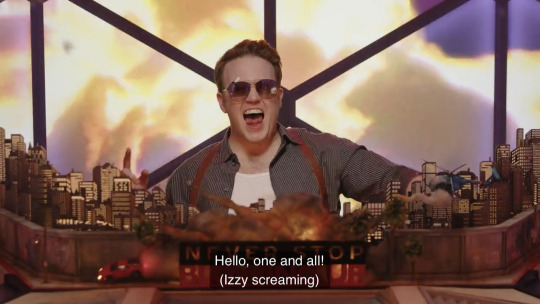
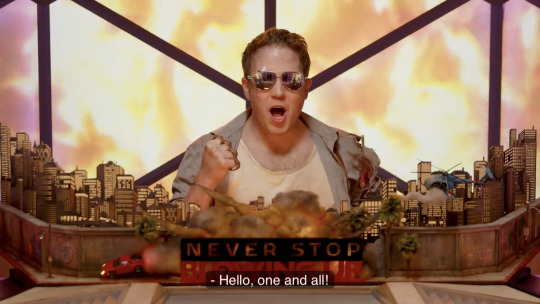
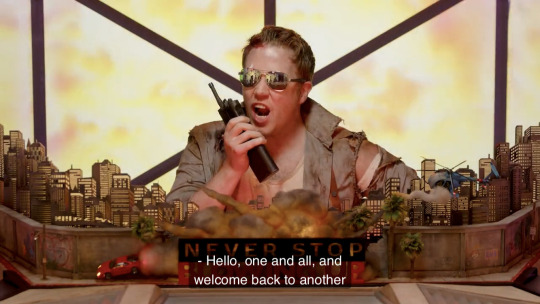
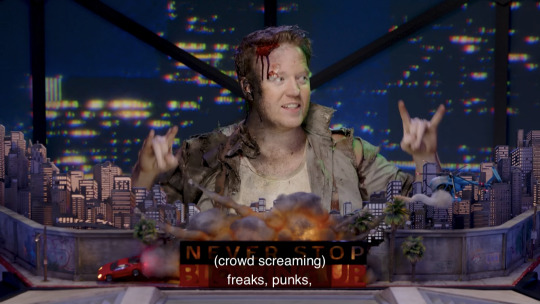
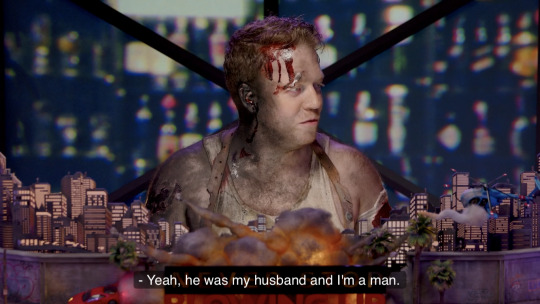
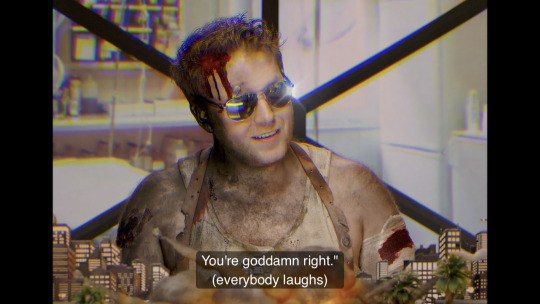
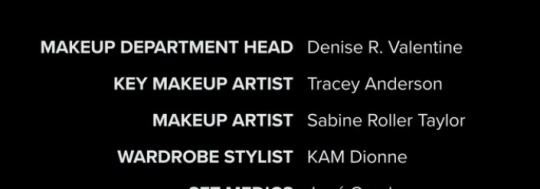
#dimension 20#dropout tv#Never Stop Blowing Up#80s#Action Movies#dropout#brennan lee mulligan#costume#cosplay#make up#Denise R Valentine#Tracey Anderson#Sabine Roller Taylor#KAM Dionne#environmental storytelling#show don't tell#media analysis#ttrpg#glow up#Kids On Bikes#Real Play#80s Action
260 notes
·
View notes
Text
Instead of just saying, “She was sad,” let your readers feel it through the details. Is she staring out the window while it rains, her favorite song playing quietly in the background? Maybe she’s avoiding eye contact, or she can’t stop fidgeting with her phone. These little moments do more to show what’s going on inside than straight-up telling us she’s upset.
#writing#writerscommunity#writer on tumblr#writing tips#character development#writing advice#oc character#writing help#writer tumblr#writblr#creative writing#show don't tell
243 notes
·
View notes
Text
A common misconception I hear people say about "show, don't tell" is that showing lengthens the description, but I find the opposite to be true. "Showing" involves the right word choice that portrays a lot in just a few words, whereas telling takes more words to describe things.
For example:
Telling: After Seth listened to the disturbing song, he said, "I am so traumatized. That song will give me nightmares. It has changed me forever."
Showing: After Seth listened to the disturbing song, he said, "I miss the person that I was three minutes ago."
#writing#writers#writeblr#writers on tumblr#creative writing#writing community#writing advice#writing tips#on writing#writing tips and tricks#authors of tumblr#author advice#show don't tell#creative process#tumblr writers#how to write#am writing
91 notes
·
View notes
Text
why i hate "show don't tell"
this is inspired by a convo with a friend. feel free to discard if it doesn't resonate with you, but i thought i'd share regardless.
note, this is a highly unstructured toolbox post because i am quite literally copy-pasting my texts LMAOO
enjoy!
· · ─────── ·𖥸· ─────── · ·
personally, i hate the show don’t tell advice.
LOL
i like to think of it as animation vs reflection: if your story was a movie, what would the camera focus on?
how the characters move, the things in the background, the lighting, the twitch in their expressions, their dynamic with other people
why? because you don’t get narration or inner thoughts in shows and film. you get the visual advantage. that’s your “show”.
how do i animate my scene?
meanwhile with tell, you have the journal entries. the dialogue, the personal thoughts, the conversations with friends. you have the ranting and the musing, the thinking and the worrying. you get a peak into the character’s mind. that’s your tell.
what words did they bite back?
showing is:
the flush of rouge sparked up his neck, matching the writhe of his hands behind his back.
telling is:
his thoughts spiralled as fast as his heart raced, all entranced by the depths of her eyes.
notice how they’re both kinda “showing”? and they’re both also kinda “telling”? that’s why i don't like the advice. one is an inner perspective. what does the character feel internally? the other is how they are perceived.
꧁꧂
happy writing!
#thecomfywriter's toolbox#tcw toolbox#writing advice#writing tips#show don't tell#thecomfywriter#writers#writers on tumblr#wip#writers blog#writblr#writerblr#writing#writing community#writeblr#on writing#writerscommunity#writers and poets
57 notes
·
View notes
Text
What genuinely gets to me with Wild Robot’s story is how quickly and well done the liar revealed trope is handled. Chris Sanders has experience pulling off this same execution with the likes of How To Train Your Dragon’s first film, when Hiccup had to come clean to his dad about secretly harboring Toothless. Didn’t think it would be covered so fast as it happened though, considering most of the time it’s saved til that inevitable third act, so mad respect to them shaking things up in Wild Robot’s writing.
Much like that other respective film, Wild Robot is immediate and thorough in addressing Brightbill’s family being accidentally killed by Roz crash landing into their little nest. We see that crushing realization, along with Brightbill’s conflicting feelings toward Roz, play out in a manner working highly effectively. It may have been a terribly unfortunate accident, but it doesn’t take away whatever weight Brightbill feels. Imagine looking up to someone you always believed to be your parent, only to find out they played a part in your biological family’s untimely demise before even being born.
Obviously, it’s not Roz’s fault because she was flung into the nest by outside forces, but damn it all if his reaction didn’t hit like a truck. What stings most of all is Roz’s calculative reasoning unintentionally adding more fuel to the fire, making Brightbill feel like a mere “task” to her, instead of what she really means. Roz was still learning about what it means to be a mother. To feel truly happy and alive. This right here was the be all end all boiling point when her son shouted, "You don't understand anything! You don't feel anything! You're not my mom...”. Every parents’ worst fear is their son or daughter rejecting them out of painful circumstances, which made Roz completely rethink her entire purpose. Getting the necessary reliable help to make Brightbill achieve excellent flying consistency.

Brightbill’s bittersweet migration take off scene wouldn’t have landed anywhere near as hard as it did, if they hadn’t chosen doing the liar revealed scene so early. It builds a serious foundation of competent writing and massive heart for Roz & Brightbill’s chemistry. You want to see them talk it out, as soon as possible to clear the air. However, both are still internally sorting things out and aren’t ready, either. You get why it has to be this way, while having your heart stomped on by their silent goodbye to each other.

The migration scene brilliantly portrays those complex hardships any family, be it biological or a found one, can go through. There’s so much anyone wants to say to another loved one, but sometimes can’t find the words in their heart and you know what? That’s completely okay. Sometimes communication isn’t always needed. Sometimes a sweet expression of unconditional love and compassion is enough, too.
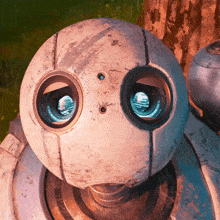
#the wild robot spoilers#that migration scene outright fucked me up in the best way#the wild robot roz#brightbill#the wild robot#show don't tell#it can do wonders for any story#their dynamic is everything to me
115 notes
·
View notes